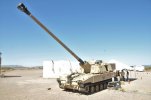Accuracy is always awesome, but when we’re talking about suppressing entrenched or armored targets, I’d give preference to 81s or 777s due to the need to cover large areas and efficiency. No need to waste a multi-million dollar rocket on a dug in fireteam.
Of course. I made a similar argument with a Marine Lt. Col. and he told me that the artillery is still headed towards guided rockets.
Precision munition prices are dropping quickly. A 155 round costs about $1,500 (probably more now) and adding precision costs $10,000 per unit. Considering tube wear and ammunition consumption that's a fair trade. It might actually be cheaper, particularly if you are flying munitions in.
I don't know what precision missiles artillery will use in the future, but hopefully it will be small and inexpensive. Ideally we will get to the point where the observer can fire the weapon from his position and there won't be a need for a crew on the firing location.
You’re talking to pilots. Most of us are well familiar with INS systems - and their tendency to drift. For long range rockets without an observer, any drift while shooting off of an INS is multiplied the further you are from the launch point. Pilots can eyeball corrections with proficiency depending on the weapons being released, but rocket artillery not so much. That’s not exactly something you want dropping near friendlies.
M31 GMLRS is the best munition available for use near friendly positions. It can be use when our troops are within 50 meters. If GPS were down due to jamming or attacks that wouldn't be the case. But M30 GMLRS has 404 explosive submunitions. You only shoot it at people you don't like.
INS inaccuracy is mitigated by shooting more than one rocket per mission. Honestly, I'm much more concerned about launcher location, as we don't have the survey teams that we would need to provide updated launcher locations so the rocket can be updated before firing. That would be as much an issue if we were shooting unguided rockets in a degraded GPS environment. There is a long range rocket on the Korean Peninsula that isn't particularly accurate and is unguided. You have to shoot a bunch to be sure of effects. It's primarily used for shooting at hardened artillery batteries that are built into bunkers, with the guns on rails. You have to detect their firing on radar and get a round to them before they roll back into cover and close the doors.
Yeah I’m in total agreement. I think
@SethB is hinting at it, but organizationally assets like these can get husbanded at higher levels preventing tactical commanders from employment. I.e. The potential for it to get treated like a land based cruise missile and wrapped up in joint target coordinating vice preplanned on call fires. This also has an effect on fires planning as well, moving coordination lines further out and leaving space inside that can be restricted from targeting by air assets. Although it’s something that has been worked around before, at-least in the Corps.
It's easy for pilots and artillerists, both of whom are airspace users, to compete for that airspace. Artillery doesn't have the same constraints as an aircraft. It may not be as accurate as a JDAM but there is no crew rest requirement, munitions can be delivered faster and artillery is largely immune to enemy ADA. Also... in the time that it takes for the USAF to generate sorties and a carrier to get in place MLRS launchers can fire hundreds of pre-ATO fire missions.
MLRS is generally used in general support as a division asset. Depending on the phase of the operation and where artillery is needed it can be pushed down to a lower level, or ordered to fire missions generated by echelons above. That allows for coordination with other airspace users. MLRS, tube artillery and mortars all have different target sets and considerations. One of the cool things about NLOS-LS was that it used a missile that could be programmed to fly a non-ballistic path, that is to say you could fire it under a coordinating altitude in order to make it responsive.
I hope all this makes sense and is a valuable contribution.


